CALL OF THE BEES
This is part two of an article on bees.
(You can find part one here)
(Swarm Season)
All text in this color is spoken
by Marieke de Vrij.
*******
COSMIC CONSCIOUSNESS
If a human being has within himself an essential reflection deep down in his soul with regard to the evolutionary urge of man and the learning processes that are subject to it, so also every animal species, including the Bee, has within his being a deeper reflection of what is brought into the atmosphere of the Earth and into the immaterial world through the creation of the Bee.
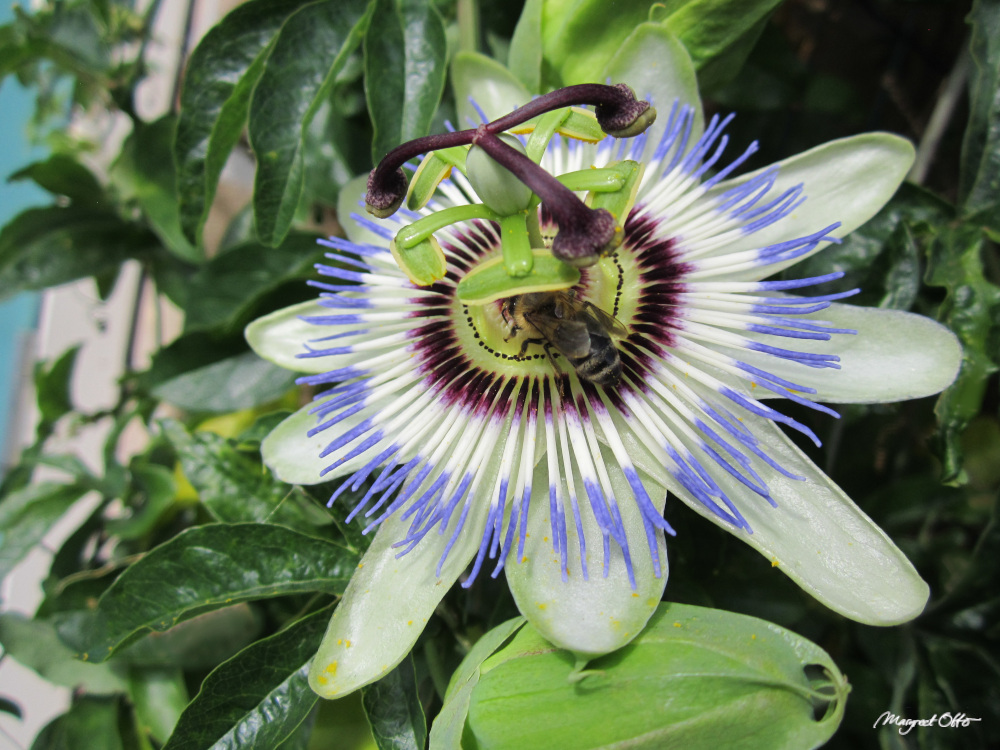
And to keep that alive, just like a human being has a ‘higher self’ and is assigned guidance from the immaterial world to support Earthly life, you can also see that towards animals, but in an animal-specific way.
Thus, the Bee’s field of consciousness continually reminds the Bee of who it can essentially be. I (Marieke de Vrij) have worked before on the nature of the Bee and I am again briefly brought into contact with how the bees describe the ether, so to speak, with their flight and its meanings.
THE MIRRORING OF BEES
Bees, as it were, describe the ether with their flight behavior, for example by repeatedly flying the same configuration in a certain direction, until the message is received, with which they visually mirror the information for other bees, and thus inform where, for example, the best flowers can be found.
Their flights have several meanings attached to them, so it is their way of communicating. They also communicate through scents and scent recognition and through vibratory signals.
Bees also have an effect on humans because -I will try to explain- when a Bee has gone through a painful field of experience, for whatever reason, the Bee always intends to rewrite what was painful in their consciousness, in something of a better order.
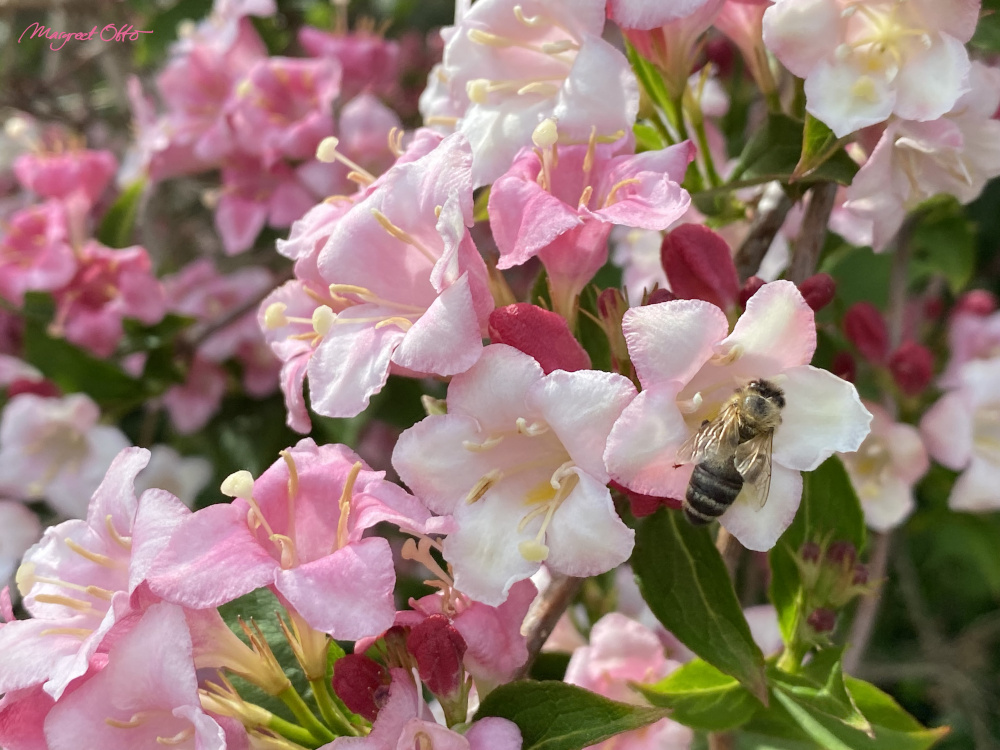
THE CALL OF THE BEES
And that means that a Bee is naturally a caller to other animal species.
But the Bee is there also for humans, the human life right?
But why is this so?
The Bee can rewrite painful histories by placing a higher order consciousness on them. So from the reflections of the Bee emanates a summoning power.
If we could understand the language of bees, we might act differently!
The evoking power thus of the Bee and the bee life to humanity is:
* * * * * * *
Whatever has happened,
take responsibility on you
to employ and call forth
your consciousness from a higher order,
to rewrite the painful,
so that you’ve erased it in time,
and will bear new progress.
* * * * * * *
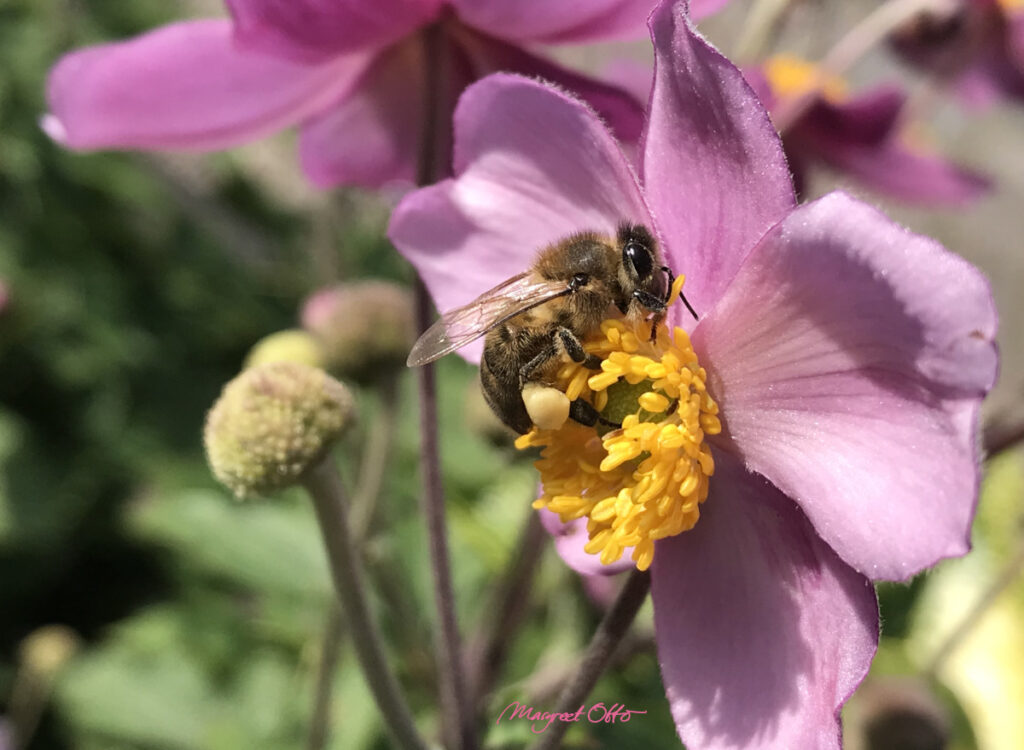
THE ‘I’ AND THE ‘WE’
A Bee is therefore an enormous connector in its inner independence, but also in its complete connection with the ‘We’. Because while he has an individual strong power of form and spirit -and you don’t always have that idea when you are dealing with a swarm of bees-, he can remain in complete connection with the ‘We’ of the colony.
So that is a character trait that humanity has yet to learn. Do you understand?
But it is in us.
However, it is often the case that when people are in pain, they just blame it to ‘We’.
After all, others have always done it, haven’t they?
Recognizable?
BEES SUFFER TOO
But bees also suffer because of many reasons. Here are just a few:
Disturbed Habitat
They suffer because of their disturbed habitat, and also because of the disturbed behavior of humans and some beekeepers.
Poisons in Habitat
For example, all the poisons in the bees’ habitat are absorbed by the bees such as insecticides, pesticides, anorganic fertilizers, genetically modified flowers and plants. The latter in a sense, also disrupts the geometric order of nature, and with it the recognition for the bee.
Cutting Wings
Then there’s the awful practice to cut the queen bee’s wings, oftentimes these are clipped halfway, so she can no longer fly. The so called reason is to prevent the queen bee to swarm, which usually doesn’t work and doesn’t make sense at all.
Cutting Legs
And what about cutting the queen’s middle or posterior legs so she can not properly place her eggs at the bottom of the brood cell? Then replacement queens are reared by the worker bees, but why is that necessary? Apart from torture, this is an interruption of the natural selection of bees.
Scientific Experimentation
There’s also scientific experimentation and scientific use where the bees are caged directly surrounding their tiny bodies, so they can’t move, but being allowed to suck a sugar solution from a dish held in front of them.
Overharvestig the Bees’ Food
Then there’s the overharvesting of the bees food by humans, honey, beepollen and royal jelly, so that the bees do not have enough food to survive themselves and feed their next generation.
Feeding with Sugar
Beekeepers often also feed the bees with sugar, a tiny amount does not matter, but in large quantities it disrupts the growth of the bee and leads to the takeover of parasites (such as the varoa mite).
All mentioned examples above are really horrible.
All we can hope for is this won’t be happening anymore and we’ll be working toward a situation that the bees, all other insects and animals (and humans) live in a balanced pristine natural environment, to ensure happiness for all. Can we co-create this?
‘HONORING’ THE PAIN
The Bee has no choice but to experience this pain, and thus has to acknowledge it.
It does so by ‘honoring’ the pain by describing its experience in a higher order of consciousness. With that, the individual pain on the spiritual level has matured more.
However, with regard to what bee life is up to today, and the painful history that the bee colonies are currently writing, it has become a struggle.
This is not because the Bee is being deprived of the ability to rewrite, but because there has never been made such an enormous intense claim for so long on the bee colony, and in such a short period of time.
REVIVAL AND REWRITING
So to revive that painful field of consciousness, ‘rewriting’, that’s what they’re doing. And because of that ‘rewriting’ by the bees, that must take place from a higher order.
The Bees also need the assistance of people.
These can be people who just love bees, or who work with them, for example beekeepers.

CONFIRM ‘WHAT HAS ALWAYS BEEN’
In this way one can impart consciousness to grant the bee colony the rightful mind that it naturally already has, by now also meeting in consciousness that he (the Bee) has it.
In this day and age, new knowledge is often reveiled that was not there, but to confirm ‘what has always been’, the acknowledgment of man towards it, is now extremely important!
So if there are people who have that awareness, and who want to give this recognition to the bee colony, that strengthens the awareness of the Bee once again.
GRID OF SELF RECOGNITION
When bees walk over the honeycomb, which you could describe as a kind of ’tripping’, they walk, as it were, a grid of self-recognition.
It is as if due to the structure of the honeycomb and the rhythm of movement of what activates the Bee in the walk of the grids, i.e. the outline of the honeycomb, that the Bee is thereby also grounding a deeper imprint of its own consciousness in the honeycomb and thus also in the Earthly sphere.

‘TRIPPING’ ON THE HONEYCOMB
Just as a human being is a spiritual being who is assigned a body in which the soul lives, then the physical body is therefore the temple of our soul, the bee body is the guardian of the spiritual being of the soul-being of the Bee.
But through the tripping on the honeycomb, and the shape of the honeycomb it walks, the Bee’s stored field of consciousness is, as it were, incarnated more deeply into matter.
And the word grid… I never use the word.
CAN YOU SEE IT?
The following suggestion is funny in itself if you think about the way it can be viewed. But in the process of walking, it can be an interesting discovery!
So here it is:
If people want to experience a deeper Bee consciousness, walking in the shape of a honeycomb is supportive as they connect with bee life.
So if you ever do meditation on bees you could draw a honeycomb for the individual participants who are going to walk the honeycomb structure.
And then walk on a zen level.
It does something, I think you will only notice that when you walk on it.

PLOTS OF HONEYCOMB STRUCTURE
That basic structure is so telling, so you can even imagine that if you’re gardening organically, maybe you could allocate certain plots designed with an enlarged honeycomb structure (thus a hexagonal structure).
CREATING FLOWER BEDS
These can be flower beds filled with honey loving flowers, that the bees really love also.
Because by building such honeycomb structures you are once again confirming: ‘we respect who you are’ (you = the bees), and the recognition of how they build their structures.
I’d be very curious to see what that does, as confirmation to bee life.
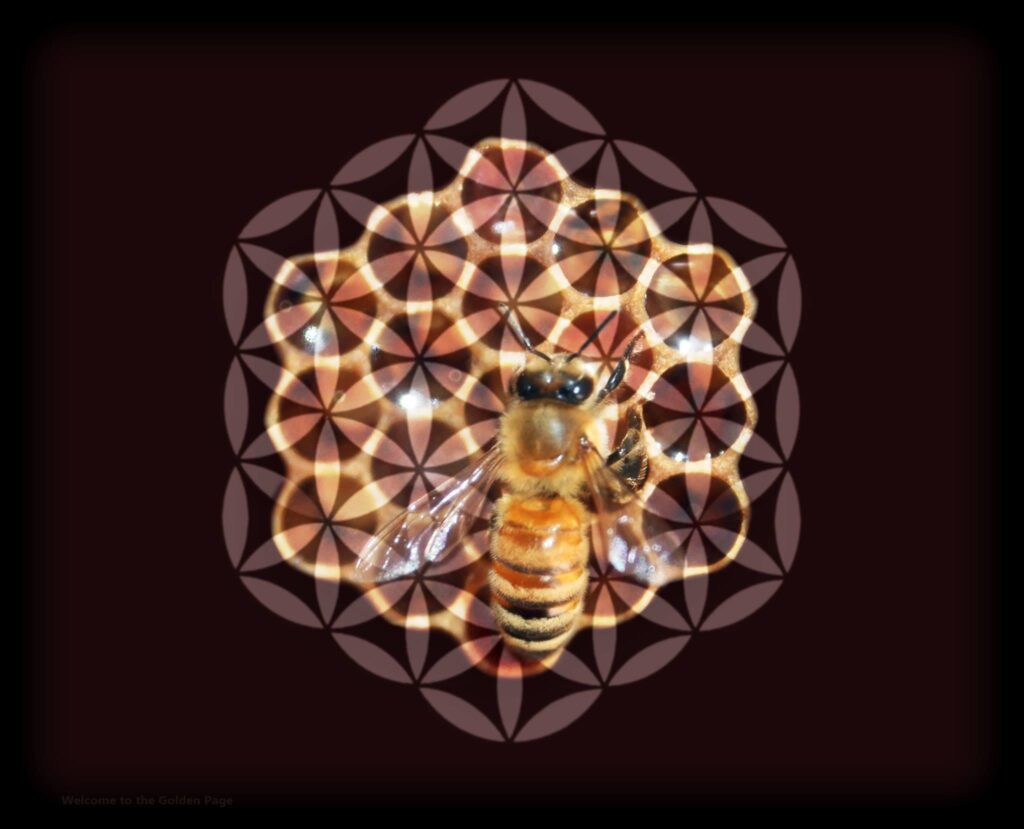
ORGANIC OPENNESS
In Dutch language, the most intense form of organic agriculture is called ‘bio-dynamic agriculture’. In this field of natural farming there is an openness. There are individuals who are open to researching the effect of flower beds laid out in a honeycomb structure.
If you go about it sincerely, one could see experimentally the effect of the flowerbeds within a honeycomb structure, versus the flowerbeds that do not have this structure. And then see the difference between the two with regard to the concentration of bee life. It’s worth investigating.
SOMETHING ABOUT THE SIZE
I have tuned in whether the dimensions, apart from the equal lines, are still important for the field of observation of the Bee.
If you create every plot with one meter as a diagonal, and you join them one after the other, then you eventually have created a honeycomb structure that you put down in a field when several plots come together.
EFFECTIVE LAY OUT
Connecting every plot together to other whole plots is often the most effective way to lay out the two dimensional honeycomb structure on the ground.
Because if you create it with larger separate outlines, then you are left with loose pieces of soil.
And here you actually systematically have a very nice division of the surface that provides a good overview.
The sight of this from above gives the bees a structured overview feeling.
WHAT FLOWER TYPES?
This way you can also see experimentally whether certain types of flowers are more popular than others. Because you can do it just like bird watchers look at birds, so you can look at bees, so it is clear which flowers they love most and in which season.
NATURAL BORDER OF THE FLOWER BEDS
When creating the flower beds, I suspect that it is best to use natural materials to create the borders, such as wood boards or stacked stones or bricks.
So please no plastic lines, you know? It’s a real fun experiment!
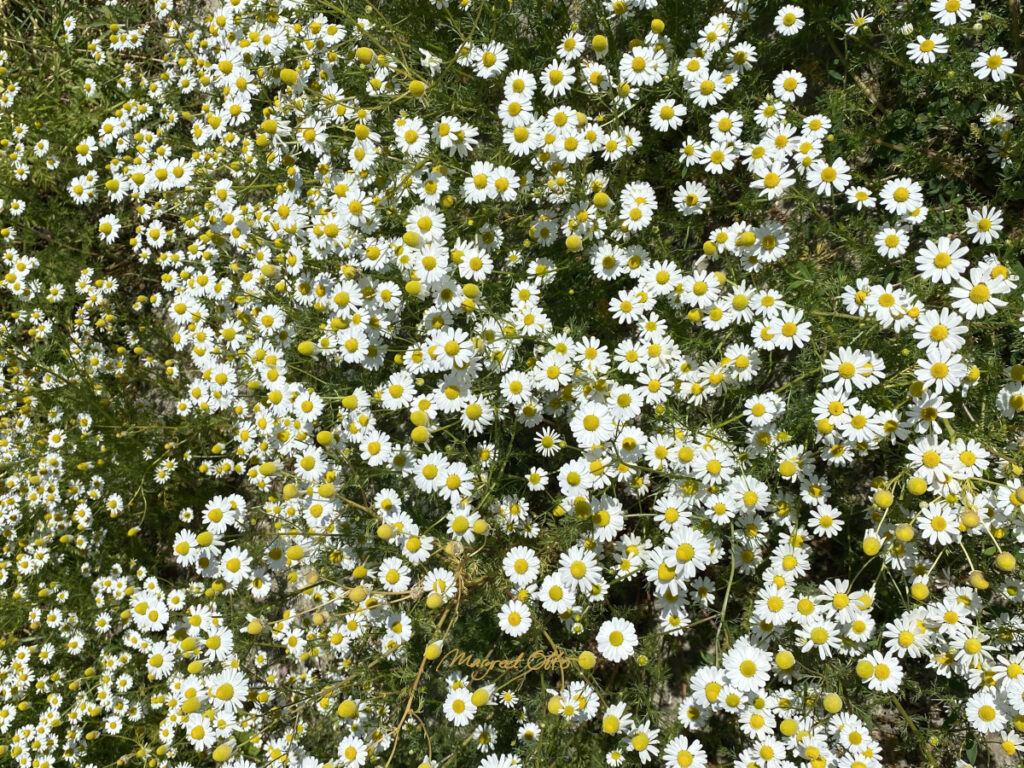
Camomille Flower Bed
A SOFT ATMOSPHERE
A Bee loves a soft atmosphere very much. He wants to ‘get home’ in the field of flowers. A very soft atmosphere in such area can also be evoked with meditation of people! When people are present in a deepened beautiful atmosphere, they can as it were ‘welcome the bees energetically’.
Could this be done by setting an intention and emptying the mind?
If a bee joins or flies around, as if the message was sensed, then the meditation group has to leave the field after meditation. One person at a distance can still follow it, but not as a whole group.
Because the bees don’t need too much interference.
THE EARLY MORNING HOURS
So I would say if you walked into a room or field where you meditated in a beautiful way, you can sometimes feel it. You sometimes have houses and you enter and you already feel welcome without having said anything, such an atmosphere, bees are very sensitive to that.
Sometimes the lush nature itself can activate such an atmosphere, but nowadays there is often so much commotion in places and activities and ‘ether aggravation’ that it is not just there, and then you can deliberately bring it to such a place. And maintain it.
The early morning hours are most suitable for this because the ether is then least burdened with information, or in the night hours when all sounds are silenced. But natural bee populations also like peace and the early morning hours are better.
THE HONEYCOMB SETUP
I (Marieke de Vrij) remember in Drenthe, certain groups – I don’t know the people – are regularly busy meditating at ‘Hunebedden’. This is the Dutch word for dolmens. I once thought I’d go to a Hunebed and you run into a field of energy that just hangs there.
So one can be meaningful in that sense, even if you sit in circle formed in a big honeycomb shape, as we happen to be doing right now (during the lecture).
You can also take that into account, with honeycomb setups. Who knows what it does. Just try it experimentally. Because there’s a special reason that the Bee uses this type of grid, it is very much part of its uniqueness to life.

ADDITIONAL FEEDING OR NOT?
Beekeepers sometimes have doubts about whether they should supplement their bee colonies or whether the bees should collect all their food on their own, even if they are in the vulnerable phase of swarming.
When supplementary feeding is really necessary, that supplemental feeding is most desirable from honey that comes from the lands where the bees are nested. That’s because bees are highly developed telepathically.
Fragrances and image information are attached to the honey, which can be traced to the bee. If the additional honey comes from a different area from further away, and perhaps with very different characteristics and vegetation, then the Bee cannot properly place its orientation. Because now the Bee absorbs images and fragances of an area it does not know.
LOCAL HONEY
So that’s really the very last thing if you have to choose to do that from another region. The honey should therefore preferably come from the region where the new swarm will soon get their honey from, from the same region, so it is most suitable. So maybe a few blocks away, as close as possible to where the new bee colony lands or will be housed.
So if you really see that a bee colony is getting too exhausted and can’t get the job done, then it is allowed to feed extra during this time because the importance of bee survival is very important right now. There is too much unnatural input on bee life to go on jokingly so to speak.
UNREST AROUND THE BEEHIVE
But don’t feed the bees until you notice chaos ensuing. You can see it in the flight behavior, it is becoming more restless, there are more intervals in the flight behavior around the hive. A decay of sound is almost heard.
Not because you’re quietly working, but the gloom surrounding the hive is increasing. If you are energetically aware of that, feed them with small spoonfuls of honey so you can keep track of what they need.
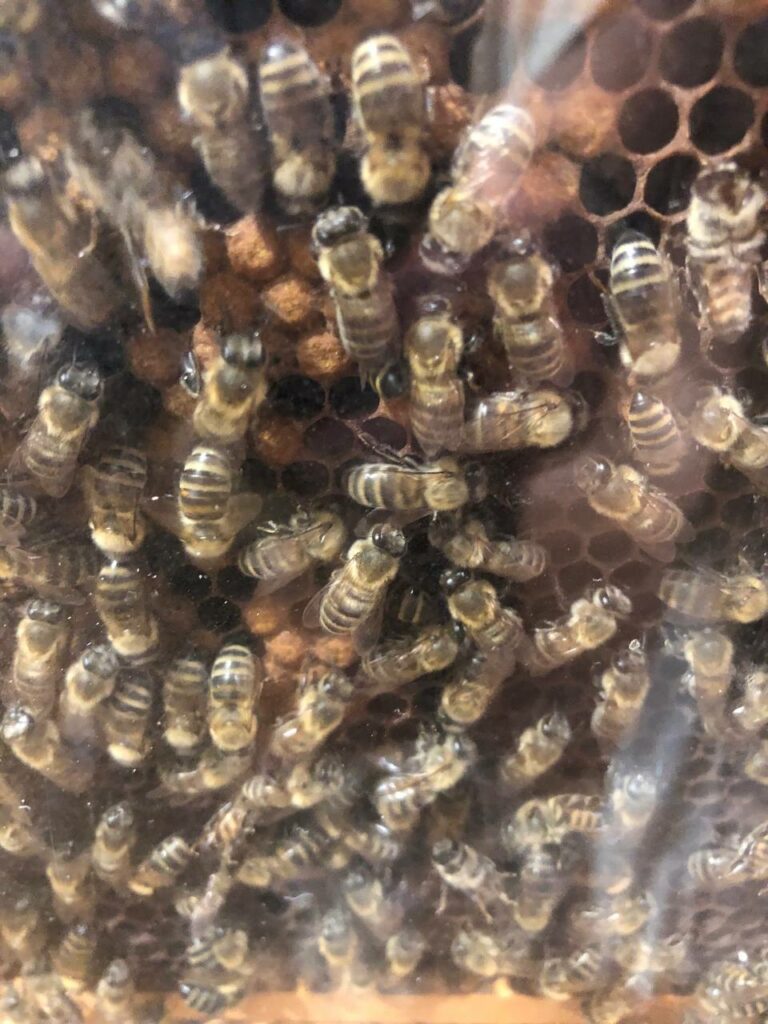
RECOVERY BEHAVIOR
Sometimes there is very fast recovery behavior with just a small supply of honey, and you can stop supplementing. But every time you feel ‘now it’s sinking’, a little bit of honey is reward for all the work the bees do. And it’s really about little bits.
And every time, compare it to people, if you get exhausted and you eat something very vital, just a snack, then you can take it again for a while and then you have the courage to activate energy yourself again. But it should not sink too deeply.
SUPPLEMENTARY FEEDING FOR THE SPRING
It is best to remove some honey from the comb in the autumn, because it can be stored very well as supplementary food for the next flight or swarm in the spring, if necessary. The entrance to the hive should be left alone, so from where the bees fly in and out.
The honey is best obtained deeper in the hive, if you scrape off from the main route that goes inside. Then you leave the rest of the surrounding honeycomb intact.
This way you kind of supply a route for next spring when the old bee colony swarms out with the mature queen, like you’ve also cleared the way a bit, that it’s not disadvantageous.
THE RIGHT HARVEST TIME
Autumn in September for the northern hemisphere is also the right harvest time. You sometimes have bee colonies that are doing so well that they are overproductive, and you can do that.
Because they don’t know when to stop, certainly not as long as there are still flowers that have beautiful pollen. But how much you can get out of it, is a sensitive assesment.
For instance, if you see that there is a great autumn and you have a colony that is over-productive because they are still in good spirits at summer time, it can be very wise and foresighted to also harvest something extra for the bees next spring themselves.
Bombus Hortorum. In Dutch language we call them ‘Garden Hommel’.
SITUATION SKETCH
Because you don’t know what kind of winter awaits you, to scrape off some of that honeycomb from the excess in September, so that the bees will replenish it at the end of September and October.
And it’s also good to keep an eye on weather reports and see how the crops are still flowering in the field.
And also to estimate how dynamic the colony has been or not, -for example, there may be underlying diseases that have reduced their vitality-.
So all of that is customization. But it is possible because if the summer has been very good, and you have a vital population, then it will not harm the population.

This is what an apiary might look like on a family estate. This one has the rattan skeps as well which are still in use! The beehives here are also old. In total there are seven boxes & baskets stacked on top of each other.
When these are properly cleaned before being offered to a swarm of bees, they can be of great service. Beehives and skeps can also be bought new online, or made by yourself. Nowadays you can even take courses for that.
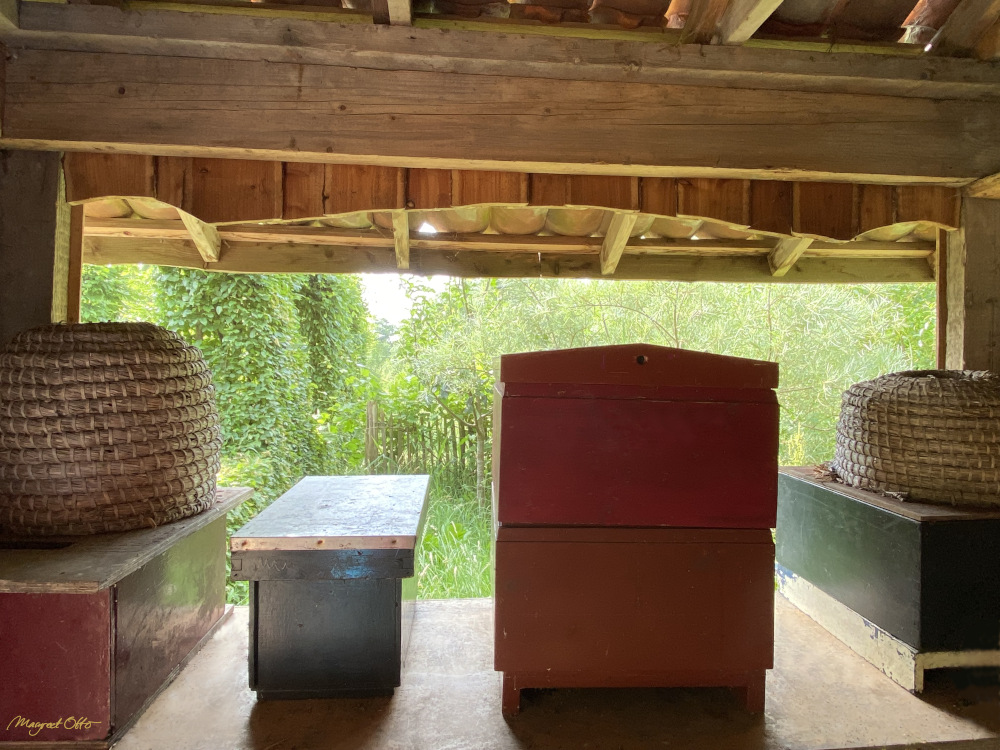
This is the apiary on the inside at the back of the beehives and the two wicker skeps. The green in the background is the flight paths of the bees.
OPTIMAL STRUCTURE
It is interesting in itself that Marieke de Vrij mentioned that the honeycomb structure has an important function for bees to fulfill. Some things about the honeycomb structure have also been written on this website as well as on www.EarthHectareGrid.com, while this information was not yet known to me.
For example, I wrote earlier that for the bees, building a three-dimensional honeycomb is the most optimal shape and structure to build. First of all, it is a sturdy construction, and secondly, it uses the least amount of material which the bees have to collect and produce themselves.
WHAT AN INGENUITY!
That is an enormous ingenuity that is contained in the creation of the Bee as a being. This saves the bees, among other things, a lot of time for collecting raw materials in nature for the wax (with which they build the comb) as well as the conversion & production thereof in their own Bee bodies.
In this context it is also interesting to mention that water in a frozen state has a three-dimensional hexagonal structure, which has been visualized by means of photography. After all, water is one of the main elements of life.
HONEYCOMB HECTARES
It is therefore special that Marieke has given the suggestions to give plots of land the shape of a honeycomb structure, such as flower beds. This could also be done with, for example, a vegetable garden, or much larger, such as family domains in a hectares village, which this website is about. For the newcomers to this website, you can read more about it here:
VILLAGES CO-CREATION
TOP EFFICIENCY
In short, this means that for humans, the surface of a honeycomb structure enlarged to hectares, could also be an optimal pattern for families to live on. It is the most efficient form of dividing a large lot of land into many parcels, because there are indeed no leftovers. In this way, the land is used optimally.
At the same time, this shape also provides an optimal spatial infrastructure because the plots can be easily approached and connected on no less than six sides, and the surrounding roads of all plots provide a fast and efficient passage.
THE ONLY NUMBER YOU NEED TO REMEMBER
As an addition for the above mentioned purpose, basically 64 metres or 70 yards is the only number you need to remember when you want to create a honeycomb hectare parcel! This length is half of the diagonal of a circle, with which a hexagonal hectare shape can be constructed.
To create the hexagonal flowerbeds, a stick of 1 meter can also be turned around with the middle of the meter (thus 50 cm) as the center point. Or just use a cord or stick of 50 centimeters and create a circle with that.
Well, was this another call from the bees?
BEES IN A HECTARES VILLAGE
Many Bee colonies will certainly flourish in a Hectares Village. Nowadays, beautiful wooden beehives and wicker skeps have also been designed in which bees can make their own combs. These hives are a feast for the eyes, and when there are -yet- not many natural shelters in the area, the bees are very happy with them!
ALL IN ALL, HELP THE BEES INTO THE NEW WORLD!
* * * * * * *
Margreet Wilschut

Back to MENU


